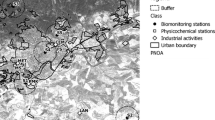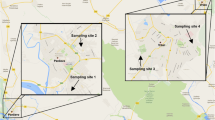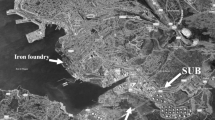Abstract
The degree of heavy metal (Hg, Cr, Cd, and Pb) pollution in honeybees (Apis mellifera) was investigated in several sampling sites around central Italy including both polluted and wildlife areas. The honeybee readily inhabits all environmental compartments, such as soil, vegetation, air, and water, and actively forages the area around the hive. Therefore, if it functions in a polluted environment, plant products used by bees may also be contaminated, and as a result, also a part of these pollutants will accumulate in the organism. The bees, foragers in particular, are good biological indicators that quickly detect the chemical impairment of the environment by the high mortality and the presence of pollutants in their body or in beehive products. The experiment was carried out using 24 colonies of honeybees bred in hives dislocated whether within urban areas or in wide countryside areas. Metals were analyzed on the foragers during all spring and summer seasons, when the bees were active. Results showed no presence of mercury in all samples analyzed, but honeybees accumulated several amounts of lead, chromium, and cadmium. Pb reported a statistically significant difference among the stations located in urban areas and those in the natural reserves, showing the highest values in honeybees collected from hives located in Ciampino area (Rome), next to the airport. The mean value for this sampling station was 0.52 mg kg−1, and July and September were characterized by the highest concentrations of Pb. Cd also showed statistically significant differences among areas, while for Cr no statistically significant differences were found.
Similar content being viewed by others
References
Celli G, Maccagnani B (2003) Honey bees as bioindicators of environmental pollution. Bull Insectol 56:137–139
Leita L, Muhlbachova G, Cesco S, Barbattini R, Mondini C (1996) Investigation on the use of honeybees and honeybee products to assess heavy metals contamination. Environ Monit Assess 43:1–9
Porrini C, Ghini S, Girotti S, Sabatini AG, Gattavecchia E, Celli G (2002) Use of honeybees as bioindicators of environmental pollution in Italy. In: Devillers J, Pham-Delegue MH (eds) Honeybees: estimate the environmental impact of chemicals. Taylor & Francis, London, pp 186–247
Celli G (1994) L'ape come indicatore biologico dei pesticidi. In: D'Ambrosio MT, Accorti M (eds) Atti del Convegno: "L'ape come Insetto Test dell'Inquinamento Agricolo" P.F "Lotta Biologica e Integrata per la Difesa delle Colture Agrarie e delle Piante Forestali", March 28th, 1992, Florence, Italy. Ministero Agricoltura e Foreste, Rome, pp 15–20
Bogdanov S (2006) Contaminants of bee products. Apidologie 37:1–18
EPA Method 7473 (1998) Mercury in solids and solutions by thermal decomposition amalgamation and atomic absorption spectrometry
Voorspoels S, Covaci A, Maervoet J, De Meester I, Schepens P (2004) Levels and profiles of PCBs and OCPs in marine benthic species from the Belgian North Sea and the Western Scheldt Estuary. Mar Poll Bull 49:393–404
Nguyen HT, Kim KH (2008) Chromium concentration levels on the Korean peninsula between 1991 and 2006. Atmos Environ 42:5015–5031
Kotàs J, Stasicka Z (2000) Chromium occurrence in the environment and methods of its speciation. Environ Pollut 107:263–283
Harmens H, Norris DA, Koerber GR, Buse A, Steinnes E, Rühling AA (2007) Temporal trends in the concentration of arsenic, chromium, copper, iron, nickel, vanadium and zinc in mosses across Europe between 1990 and 2000. Atmos Environ 41:6673–6687
Harmens H, Norris DA, Koerber GR, Buse A, Steinnes E, Rühling AA (2008) Temporal trends (1990–2000) in the concentration of cadmium, lead and mercury in mosses across Europe. Environ Poll 151:368–376
Conti ME, Botrè F (2001) Honeybees and their products as potential bioindicators of heavy metals contamination. Environ Monit Assess 69:267–282
Acknowledgments
The authors thank beekeepers Giuliano Cacciatore and Nino Mancini for their excellent cooperation and helpfulness. Pacha Mama, CRA, and IZS are also thanked for their technical support.
Author information
Authors and Affiliations
Corresponding author
Rights and permissions
About this article
Cite this article
Perugini, M., Manera, M., Grotta, L. et al. Heavy Metal (Hg, Cr, Cd, and Pb) Contamination in Urban Areas and Wildlife Reserves: Honeybees as Bioindicators. Biol Trace Elem Res 140, 170–176 (2011). https://doi.org/10.1007/s12011-010-8688-z
Received:
Accepted:
Published:
Issue Date:
DOI: https://doi.org/10.1007/s12011-010-8688-z




